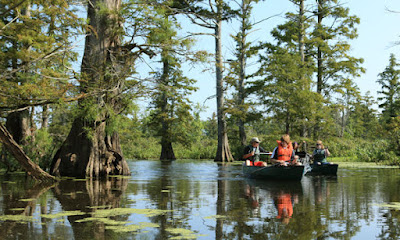The Cache River State Natural Area is a swamp home to bald cypress trees, some of which are over 1,000 years old. It was created when glaciers receded from the area thousands of years ago. The area’s wooded hills and cypress swamps make it similar to the bayous of Louisiana.
Visitors to the area can check out the Barhausen-Cache River Wetlands Center, which is open to the public five days a week. There is a 2,000 square foot exhibit area, audio visual room, and wildlife viewing area. Visitors are invited to explore the cultural and natural history of the Cache River watershed along a timeline in the exhibits. There are also orientation videos, interactive touch screens featuring images of the Cache and migratory birds, information on local flora and fauna, and changing landscape displays.
Outside, the grounds offer a 2,600 handicap-accessible hiking trail which has a wildlife viewing mound overlooking a re-established wetland along the old bed of Cypress Creek. Depending on the season, pileated woodpeckers, prothonotary warblers, or winter wrens may serenade your stroll, which provides a great view of the state champion water tupelo. This majestic aquatic tree has a huge circumference of 22.5 feet and is known for its wide base that tapers into a long, narrow trunk and then spreads out at the top like a crown. Along the 450-foot boardwalk, a total of 10 tree species are identified.
Observant birders can expect to see bald eagles, red-tailed hawks, great-horned owls, barred owls, great blue herons, great egrets, little blue herons, green herons, least bitterns, wood ducks, mallards, snow geese, sora rails, woodcock, quail, mourning doves, red-headed woodpeckers, pileated woodpeckers, prothonotary warblers, black vultures and turkey vultures. Seasonal migrations bring multitudes of waterfowl and shorebirds to the area, as well as the occasional osprey, golden eagle and black tern.
Mammals often encountered include white-tailed deer, squirrels, raccoons, beavers, gray foxes, red foxes, opossums, skunks, minks, and even river otters, bobcats, or tiny Indiana bats. Several types of frogs are also prevalent, and there are cottonmouth, copperhead and timber rattlesnakes. The swamps also include numerous fish, amphibians, and reptiles, including channel catfish, crappie, bass and bluegill that are sought after by area fishermen.
The Cache River State Natural Area offers more than 18 miles of hiking trails. The Wetlands Center is also the beginning or terminus of a bike ride or walk on the Tunnel Hill State Trail, which extends 48 miles north to Harrisburg. Today, a cooperative effort called the Cache River Wetlands Joint Venture Partnership is working to protect and restore a 60,000-acre wetland corridor along 50 miles of the Cache River. The focus is to repair natural ecosystems and provide hunting, fishing, hiking, canoeing and other recreational opportunities, which in turn will promote economic development and tourism.
State Representative Patrick Windhorst, a southern Illinois native, is raising his family in Metropolis in Massac County. The 117th district State Representative says he is proud to represent an area rich in natural resources and beauty.
“Southern Illinois is home to a wide variety of tourist and recreational activities with our rivers, wildlife, lakes, forests, and trails,” Windhorst said. “The opportunities to canoe, kayak, hike, camp, fish, and participate in other outdoor recreational activities are plentiful, and the Cache River State Natural Area adds to the rich and plentiful natural wonders we are blessed with.”
Deep southern Illinois is also home to another ancient cypress swamp, a 149-acre property in Alexander County. In 2016, HeartLands Conservancy, with funding from the Illinois Clean Energy Community Foundation and Grand Victoria Foundation, acquired this property. This area, which includes an ancient cypress swamp and frequently flooded farmland, was a high priority for the U.S. Forest Service because of its location within the Mississippi River floodplain and its natural features. In September 2021, HeartLands Conservancy sold the land to the Forest Service for inclusion in the Shawnee National Forest.


